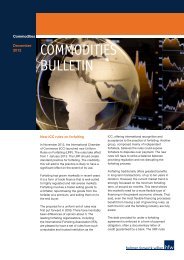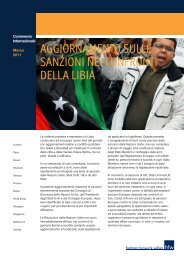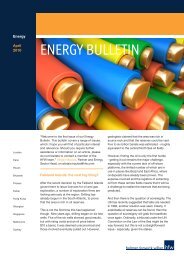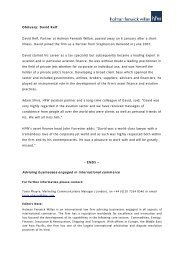GLOBAL GA - Holman Fenwick Willan
GLOBAL GA - Holman Fenwick Willan
GLOBAL GA - Holman Fenwick Willan
Create successful ePaper yourself
Turn your PDF publications into a flip-book with our unique Google optimized e-Paper software.
The EU ETS: simplified<br />
procedure for small emitters -<br />
not so simple?<br />
Introduction<br />
The EU’s Emissions Trading System<br />
(or Emissions Trading Scheme, as it<br />
is more commonly known) (“EU ETS”<br />
or “the Scheme”) was extended to<br />
include the aviation industry from 1<br />
January 2012. Although the subject<br />
of intense scrutiny and attack, a legal<br />
challenge against the EU ETS by the<br />
Air Transport Association of America,<br />
supported by the International<br />
Air Transport Association and the<br />
National Airlines Council of Canada,<br />
was dismissed by the European<br />
Court of Justice in December 2011.<br />
Although this is by no means the<br />
end of the story, the EU ETS has<br />
now come into effect for the aviation<br />
industry and is likely to remain so<br />
notwithstanding ongoing legal and<br />
political challenges to its validity.<br />
This article considers the effect of<br />
the Scheme on ‘small emitters’, with<br />
a particular focus on the problems<br />
already being experienced by<br />
business aircraft operators.<br />
Background<br />
The EU ETS is a market-based “cap<br />
and trade” scheme for environmental<br />
improvement that allows participants<br />
to buy and sell emissions allowances<br />
i.e. the right to emit a fixed amount<br />
of emissions each year. At the end<br />
of each trading year, operators<br />
must “surrender” allowances which<br />
correspond to their actual emissions<br />
for that year. A certain number of<br />
free allowances are allocated to each<br />
operator based on a benchmark<br />
figure set by the European<br />
Commission (“the Commission”) and<br />
02 General Aviation Bulletin<br />
tonne-kilometre data provided by that<br />
operator for the year 2010. Unused<br />
allowances can be sold to other<br />
operators but additional allowances<br />
must be purchased if extra emissions<br />
are made, or serious penalties may<br />
be applied. The Scheme places<br />
obligations on operators to monitor,<br />
report and verify (“MRV”) their<br />
emissions data.<br />
In essence, an aircraft operator falls<br />
under the EU ETS if it performs flights<br />
to, within or from the EU. However,<br />
if an operator only operates exempt<br />
flights (set out in Annex I of Directive<br />
2003/87/EC) or is a commercial air<br />
transport operator falling below the<br />
de minimis threshold (see below), the<br />
operator is not caught by the Scheme.<br />
Important Annex 1 exemptions for the<br />
<strong>GA</strong> market include military flights,<br />
search and rescue flights, flights<br />
performed exclusively under visual<br />
flight rules, flights departing/arriving<br />
at the same aerodrome (where no<br />
intermediate landing has been made),<br />
training flights performed exclusively<br />
for the purpose of obtaining a licence,<br />
and flights performed by aircraft with<br />
a certified take-off mass of less than<br />
5,700kg.<br />
The de minimis threshold: “small<br />
emitters”<br />
A commercial aircraft operator is<br />
defined in the relevant EU legislation<br />
as an operator with an Air Operator’s<br />
Certificate under Part I of Annex 6 to<br />
the Chicago Convention. If a noncommercial<br />
operator operates fewer<br />
than 243 flights per period for three<br />
consecutive four-month periods (Jan-<br />
April, May-Aug, Sep-Dec) or operates<br />
flights with total annual emissions<br />
of less than 10,000 tonnes CO 2 per<br />
year (the de minimis threshold), it is<br />
considered to be a “small emitter”<br />
for EU ETS purposes. Commercial<br />
operators who operate below the de<br />
minimis threshold are exempt from<br />
EU ETS altogether. Small emitters<br />
are permitted to use a simplified<br />
procedure for calculating their annual<br />
emissions, which is designed to<br />
ease the administrative burden of<br />
compliance with some aspects of the<br />
Scheme.<br />
Although many business aircraft<br />
operators fall below the de minimis<br />
threshold, the European Business<br />
Aviation Association (EBAA) has<br />
intensively lobbied the Commission<br />
regarding the arbitrarily low limit of<br />
10,000t of emissions. We understand<br />
that, in December 2011, the<br />
Commission agreed to increase the<br />
threshold to 25,000t (EBAA wanted<br />
a higher limit of 50,000t), although<br />
this is not expected to come into play<br />
until 2013.<br />
The simplified procedure: is it really<br />
that simple?<br />
Eurocontrol has produced a ‘small<br />
emitters tool’ (“SET”), which has<br />
been approved by the European<br />
Commission and can be used by<br />
small emitters to determine their<br />
fuel consumption for EU ETS<br />
monitoring and reporting purposes.<br />
The SET provides an estimate of fuel<br />
consumption based on the actual<br />
flight distance and a representative<br />
fuel burn model for the aircraft type.<br />
It uses the standard density for jet<br />
kerosene of 3.15 tCO 2 /tfuel to provide<br />
an estimate of the amount of CO 2<br />
produced per flight.<br />
Although the SET is free to use, small<br />
emitters are still required to adhere<br />
to the formal standard reporting and<br />
verification requirements set down<br />
by the Commission. Unsurprisingly,

















